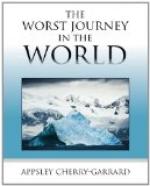[359] My own diary.
[360] Ibid.
[361] My own diary.
[362] My own diary.
[363] My own diary.
[364] Ibid.
GLOSSARY
BLIZZARD. An Antarctic blizzard is a high southerly wind generally accompanied by clouds of drifting snow, partly falling from above, partly picked up from the surface. In the daylight of summer a tent cannot be seen a few yards off: in the darkness of winter it is easy to be lost within a few feet of a hut. There is no doubt that a blizzard has a bewildering and numbing effect upon the brain of any one exposed to it.
BRASH. Small ice fragments from a floe which is breaking up.
CLOUD. The commonest form of cloud, and also that typical of blizzard conditions, was a uniform pall stretching all over the sky without distinction. This was logged by us as stratus. Cumulus clouds are the woolly billows, flat below and rounded on top, which are formed by local ascending currents of air. They were rare in the south and only formed over open water or mountains. Cirrus are the “mare’s tails” and similar wispy clouds which float high in the atmosphere. These and their allied forms were common. Generally speaking, the clouds were due to stratification of the air into layers rather than to ascending currents.
CRUSTS. Layers of snow in a snow-field with air space between them.
FINNESKO. Boots made entirely of fur, soles and all.
FROST SMOKE. Condensed water vapour which forms a mist over open sea in cold weather.
ICE-FOOT. Fringes of ice which skirt many parts of the Antarctic shores: many of them have been formed by sea-spray.
NUNATAK. An island of land in a snow-field. Buckley Island is the top of a mountain sticking out of the top of the Beardmore Glacier.
PIEDMONT. Stretches of ancient ice which remain along the Antarctic coasts.
PRAM. A Norwegian skiff, with a spoon bow.
SAENNEGRASS. A kind of Norwegian hay used as packing in finnesko.
SASTRUGI are the furrows or irregularities formed on a snow plain by the wind. They may be a foot or more deep and as hard and as slippery as ice: they may be quite soft: they may appear as great inverted pudding bowls: they may be hard knots covered with soft powdery snow.
SLEDGING DISTANCES. All miles are geographical miles unless otherwise stated, 1 statute or English mile = 0.87 geographical mile: 1 geographical mile = 1.15 statute miles.
TANK. A canvas “hold-all” strapped to the sledge to contain food bags.
TIDE CRACK. A working crack between the land ice and the sea ice which rises and falls with the tide.
WIND. Wind forces are logged according to the Beaufort scale, which is as follows:




